Osteochondrosis is most commonly observed in the cervical spine, which is caused by the anatomical features of the department's structure. First, the cervical vertebra is very tight to each other. And second, the neck muscle frame is less advanced. For these reasons, cervical vertebrae and nerve root compression, blood vessels are so easy to lower cervical vertebrae more often affected than the upper ones.

Cimptoms cervical osteochondrosis
Clinical symptoms of cervical osteochondrosis are very diverse. Many people do not suggest all kinds of symptoms (pain in their hands, dizziness, etc. ), can be associated with neck pathology. In general, all symptoms that occur with cervical osteochondrosis can be considered in three syndrome:
- Compression-brown syndrome;
- Reflex-reflex syndrome;
- Vail artery syndrome.
Compression-in-off syndrome
Against the background of cervical osteochondrosis, intervertebral hernia, as well as osteophytes, can be formed. This structure compresses the nerve roots, leading to the occurrence of symptoms of radiculitis. Compression of each spine is associated with certain reflexes, motor, sensitive disorders:
- When compressing the C1 spine, pain occurs, as well as impaired sensitivity (decreased sensitivity, numbness, tingling skin, goosebumps sensation) in the parietal area;
- When compressing the C2 spine, the pain develops, as well as the changes in sensitivity in the parietal area and eating the head;
- When compressing C3 spine, pain is noted, as well as changes in the neck sensitivity. In addition, one may be disturbed by the swelling of the tongue on one side, the movement of language difficulty, and speech disorders.
- When compressing the S4 spine, pain is noted, as well as changes in sensitivity in the clavicle. Icote, dysphony may occur. Due to the diaphragm nerve fiber in the spine, with spinal compression, breathing, heart disease may occur.
- When compressing the C5 spine, the pain in the shoulder develops, as well as changes in skin sensitivity to the outer surface of the shoulder.
- When compressing the C6 range, the pain spreads from the neck to the shoulder blade, as well as the outer surface of the shoulder, lower arm and to the brush. Violation of skin sensitivity in this area is observed. The two headed muscles are exaggerated, the reflex is reduced.
- When compressing the C7 spine, the pain from the neck spreads beneath the shoulder blade, to the outer surface of the shoulder, lower arm and to the finger II -II hand. Violation of skin sensitivity in this area is observed. The three -headed muscles are exaggerated, the reflex is reduced.
- When compressing the C8 spine, the pain from the neck spreads to the hand to the small finger. Skin sensitivity in this area is disrupted. Hypotrophy and decreased reflexes from three head muscles occur.
For radical syndrome, acute pain and its strengthening when moving the head are characteristic.
Reflex Rengsite Syndrome
The early stages of osteochondrosis are characterized by the occurrence of reflex syndrome. With cervical osteochondrosis, the following options for reflex syndrome may occur:
- Cervicalgia is an intensive pain in the neck, which is expressed as much as possible after waking up in the morning, and even when turning on your head, cough and even laughter.
- Cervicobrachialgia - pain focuses on the neck and nape.
- Cervicobrachialgia - pain in the neck, shoulders and lower arm.
Cervicobrachalgia can occur with muscle-tonic, vegetative-vascular and neurodystrophic manifestations. Muscle tonic syndrome is the result of reflex muscle cramps. The following muscle-tonic syndrome is distinguished:
- Lower oblique muscle syndrome - characterized by persistent pain in the neck and back of the head on one side, which is very strong during the head turn;
- Reflective syndrome of its own spades with pain in the neck and the upper angle of the scapula and on the shoulder or even the surface of the chest. The characteristic feature is the increased pain during the brushing of the brush by the lower back.
Neurodystrophic syndrome includes shoulder periarthrosis, epicondi shoulders, shoulder syndrome. Shoulder -houlder periarthrosis - characterized by pain in the shoulder joint, intensively during shoulder movement or arm raising. Pain can emit arm, neck. The skin in the shoulder joint is swollen. For shoulder syndrome, the presence of spatular periattroz signs in combination with vegetative-vascular, trophic changes in the wrist joint and brush are characteristic. Brush skin becomes edematous, color change, local temperature increases. Shoulder epicondyles are neurododystrophic changes in the shoulder rod, where many muscle attachments. It is characterized by pain, persistent pain in the trunk area, increasing in the implementation of sudden movements in the elbow or brush.

Vail arterial syndrome
The vertebral artery occurs in the channel formed by the cervical vertebral process. The vessel provides blood supply to many brain structures. The narrowing of the ship is possible due to reflex spasms and mechanical compression. When narrowing the vessel, the vertebral artery syndrome is formed, characterized by the following symptoms:
- Cranially: pain, persistent headache more frequently, has increased with head movements. The pain spreads from the back of the forehead.
- The scalp pain, determined by a light touch even when combing the hair.
- Kohleovestilarnyi violations: indicated by dizziness, tinnitus (ringing in the ear), decreases in light degree, and balance violations.
- Visual disorders: dark, flashing flies in front of my eyes.
- Neurasthenic syndrome: irritation, emotional strength, sleep disorders.
- Vegetative symptoms: heat, chills, hand cooling.
- Fluctuating in blood pressure.
- With compression of the vertebral artery caused by a sharp head turn, one can lose consciousness. This option is also possible: a person falls as a primed, but at the same time conscious. Such a violation is called a drop attack.
Treatment of cervical osteochondrosis
It is very difficult to fight osteochondrosis in advanced form. Various drugs are used to eliminate the symptoms of the disease. The role of no less important is played by therapeutic gymnastics, as well as physiotherapy, massage. In some cases, wearing a special collar is very useful. People's remedies will help increase treatment.
Wearing a cervical collar
Wearing collar helps relieve muscle tension from the neck, and also gives the right position to the spine, thus eliminating compression of the vertebral artery and nerve root. Cervical collar is rigid (shantsa collar), as well as bloating. Shanz Collar is a dense frame tied around the neck. He considers all his headache, thus relaxing the muscles of the neck. Inflatable collar is a device that needs to be placed around the neck, and then with the help of attached pear, pump air. The flush collar pulls the spine. Collar is not used all day long, but a few hours a day. Flat -rata, the length of the device is a month. Please note: The need to use a collar is determined by a doctor. In case no, do not place it yourself without a doctor's prescription. In some cases, collar can prevent vessels and nerves, which can have serious consequences.
Exercise for cervical osteochondrosis

Therapeutic gymnastics are recommended for all patients with osteochondrosis without contraindications. The performance of physical training during the enlargement of the disease is contraindicated. Therapeutic gymnastics can be done after the pain decreases. Normal training performance allows you to strengthen muscle frames, as well as reduce the load on the intervertebral disc. Regular physical activity contributes to increased blood supply to the neck and as a result of normalizing the metabolic processes that occur in the intervertebral disc. A set of exercises for cervical osteochondrosis:
- Sitting on a chair. Turn your head on the right and left.
- Tilt your head down, touching the chest seizure.
- Pull your neck back, while drawing a chin.
- Put your palms on your forehead and press it, while it's important to tilt your head forward, opposing.
- Palm must often be used for temples and true -actually as in previous exercises to put resistance to head movements by hand.
- Raise your shoulders as much as possible, counting to ten. Then lower your shoulders and rest. After ten seconds, do the same manipulation.
All exercises must be repeated ten times.

























